 |
 The Happy Daylily Blog - daylily pictures and thoughts from my garden
The Happy Daylily Blog - daylily pictures and thoughts from my garden

|
 August 30th, 2015 August 30th, 2015 |
There are lots of things that make for happy daylilies with some being easier for us to accomplish than others. One of the harder things is keeping weeds down. Daylilies can co-exist with a few weeds here and there but if the weeds get the upper hand they can have a negative affect on otherwise healthy daylilies. One summer I was having some health issues and couldn't get out to weed. I was too cheap to hire someone and too pig headed to ask any of my friends so after a while you couldn't see the daylilies as the weeds were taller. I lost a number of dayliies that year from being neglected.
For years I was frustrated by weeds. Every time I would weed a bed I would have to remove even the tiniest hint of a weed. This took a lot of effort but what was frustrating was the fact that I was just preparing the surfact of the soil and within a week the weeds started sprouting again. In other words, a never ending cycle. Eventually, I discovered the joy of just getting the worst of the weeds and not worrying about the small stuff.
In addition to pulling them up, I have also tried preventing weeds from sprouting in the first place. I tried a product called Snapshot which is a pre-emergent. It was moderately successful (except for nutgrass which already existed in some of my beds). Unfortunately, it seemed to have a noticable detrimental effect on seed production so I stopped using it.
I also tried mulching. Early on I used well composted stable sweepings to mulch. Those worked best but eventually my source went out of business and every other source I could find brought in more weeds than they prevented. Then I tried a cheap mulch made from chunks of wood that were not composted or aged. They kept the weeds down but after a year much of the nitrogen in the soil had been used up trying to digest the wood chips and the daylilies declined.
More recently, I have discovered that a good quality hardwood mulch does a pretty good job. The mulch I use consists of a wide range of particle sizes from the tiniest up to a max of about 1.5". The smaller particles (almost like ground up hardwood) actually feed the soil as they slowly decompose while the larger pieces hold in moisture and help keep the weeds in check (through the summer at least). But I still have to weed.
As I was weeding today, I realized that while I don't enjoy weeding there is an important side benefit for me at least. I believe that working in the garden and especially weeding is keeping me feeling young or at least younger than I really am (smile).
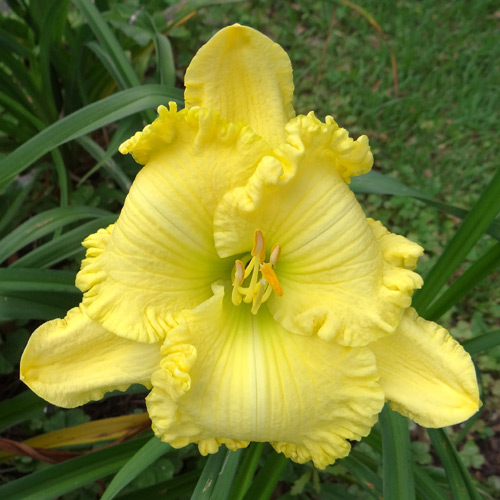
Seedling 14-071
Yellow is not a real popular color for daylilies. That could be because originally yellow and orange were pretty much the only colors available. In fact, even today there are still folks that think of yellow and orange when they think of daylilies. From a landscaping standpoint yellow is a good choice because the bright color holds its own in the garden and is visable from farther away than some of the darker or more subtle colors.
Seedling 14-071 is a very bright, light yellow so it stands out very well in the garden. Cupped sepals is not one of my favorite traits but if consistent such as in this seedling, it adds some distinction.
|
 August 28th, 2015 August 28th, 2015 |
The weather has been nicer for the past week or so. Temperatures are still in the 90's but the humidity has been down somewhat. It has been quite pleasant to be in the garden in the early evenings. I'm not naive enough to believe that fall is starting however. That seldom happens this early. In fact, the hottest day ever recorded in Houston was on September 4th, 2000 when it reached 109 degrees.
I noticed this evening that many of the daylilies are starting to put on new growth. It must be the rain. Rainwater is much better for plants than city water. 78 percent of the air is nitrogen which is a fertilizer. I believe that as the water droplets fly around in the clouds they absorb a little of the nitrogen. When it rains this nitrogen provides a little fertilizer to the plants. Could be that's why everything is so green after a good rain.
Hmmmmm... plants also need Oxygen. I wonder if I pumped Nitrous Oxide (laughing gas) into the soil if the daylilies would grow even faster. If nothing else, they would probably be quite happy (smile).
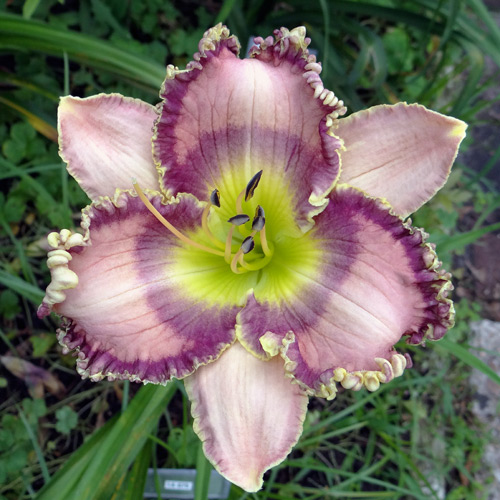
Seedling 14-075
Today's seedling is 14-075. It has a 6" bloom and decent bud count for a plant that has not yet become established.
|
 August 23rd, 2015 August 23rd, 2015 |
I have been asked what makes a seedling a "good" seedling. My answer used to always be the same - it has to have good branching and a bud count of at least 20. Of course there were other criteria such as a vigorous grower, good color, symetrical bloom form, attractive foliage, and being able to handle Houston's hot summers. To put it another way, if the daylily has enough good qualities that people would pay money for it, then it's a good daylily and worthy of being registered.
I have grown daylilies and hybridized for some 30 years now and I've always had the same definition of a good seedling. However I have now reached the point where I'd rather not work quite so hard in the garden. It's time to be able to relax and enjoy the fruits of my labor. This coming spring will be the last time I'll have new seedlings blooming and I'm cutting back the number of daylilies I grow.
Eventually, I plan to only grow some of my own registrations plus a collection of seedlings that I like. Many seedlings have faults that keep me from considering them for registration but I may like them well enough to grow them just for my self. It's the process of selecting which of these seedlings to keep that has me adding one more criteria to the question of what makes a good seedling. I call it 'the smile factor'.
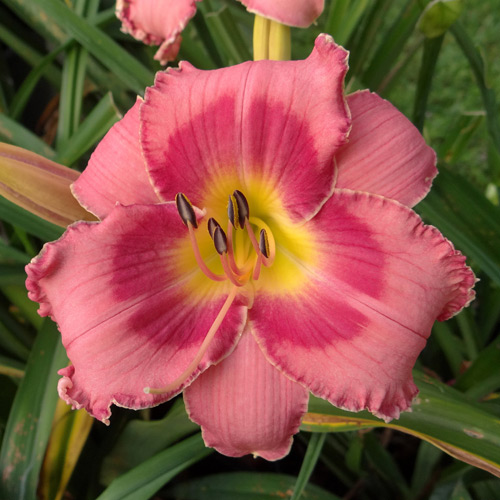
Seedling 02-021
This is seedling 02-021 and it's one of those that makes me smile. It will never be registered but I like well enough that I have grown it for 13 years now. It has never had a bud count higher than 14 but I really like the hot pink color accentuated by the red eye.
|
 August 16th, 2015 August 16th, 2015 |
The heat wave has broken and we are back to normal summer temperatures (highs in mid 90's). We haven't had any appreciable rain here at the house for several weeks so I'm continuing to water the garden.
One thing I learned the hard way was to not over water during the heat of the summer. Years ago I visited Ra Hansen in Florida during mid July. My bloom was down to practically nothing by that time and I wasn't expecting to see much in her garden. Much to my surprise, her garden looked like mine did at the beginning of June - bloom everywhere. I asked her what she did to keep the bloom going. Her answer was 'plenty of water'. She said she watered her entire garden every evening.
Well, I thought I had been given the magic formula. When I returned to Houston, I started watering every other day. I didn't have enough water pressure to water everything daily or I probably would have. And what was the result? Almost a quarter of all my daylilies died from crown rot. I was devastated.
Eventually I figured out where I went wrong. My soil which consisted of amended gumbo was staying too wet and that brought on the rot. I also found out that Florida soil is very sandy and the water just drained right through it. Ra had to water daily just to keep the soil from getting too dry.
Today after being ammended for many years, my soil drains much better but I still only water every 3rd day. That gives the soil a chance to dry out some between waterings. I have to water my pots every other day because the potting soil drains too well and every 3rd day is not enough.
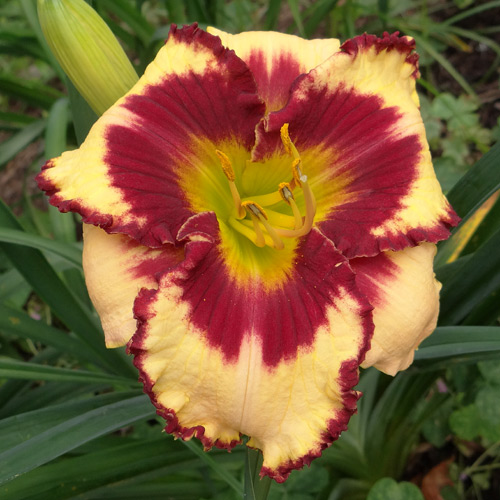
Seedling 14-062
 
Seedling 11-022 What Fun What Fun
Today's image is seedling 14-062. It came from the cross (seedling 11-022 x What Fun). What I like about this seedling is the way the gold in the throat seems to erupt part way out onto the red eye.
Interestingly enough, both parents of this seedling died from crown rot yet this seedling hasn't shown any rot issues yet. Time will tell...
|
 August 8th, 2015 August 8th, 2015 |
WELCOME TO NUTGRASS ACRES!
...at least that's what it seems like this year. Nutgrass or more correctly Purple Nutsedge, has existed in my garden for as long as I can remember. Some years it's worse than others but for the past five years or so, not so much. Then this year... WOW! I've never seen so much nutgrass in my front yard beds. At first I though I must have brought it in with my mulch but I have used the mulch before and never brought in any. So I put on my 'Sherlock Holmes' hat to see if I could figure out what was going on.
One thing I've learned over the years is that nutgrass doesn't like shade. When a bed is filled with daylily clumps so that very little sun actually makes it to the soil, I see only a few shoots. I also read recently that nutgrass loves wet soil. Nutsedge is a member of the family Cyperus. Probably the most famous member of this family is papyrus which is an aquatic plant.
So here's what I think happened. In the spring I removed two large trees that were giving way too much shade to the beds. Furthermore, the tree's roots were sucking all the water out of the soil keeping it dry most of the time. With the trees gone, the water is no longer being sucked from the soil and the beds are receiving lots of sun. In addition we had a very wet spring. My guess is that all these things combined to bring all the dormant 'nuts' back to life.
There are herbicides that kill nutgrass (Google Nutgrass killer for specifics) but unfortunately, these herbicides also kill daylilies so there's nothing that can be sprayed over the beds to kill the nutgrass. One option is to spot treat each shoot being careful not to get any herbicide on the daylilies. In my case, I'll just continue to pull up the shoots (not effective as they quickly grow back) until the daylilies reach clump strength where their shade will help keep the nutgrass in check.
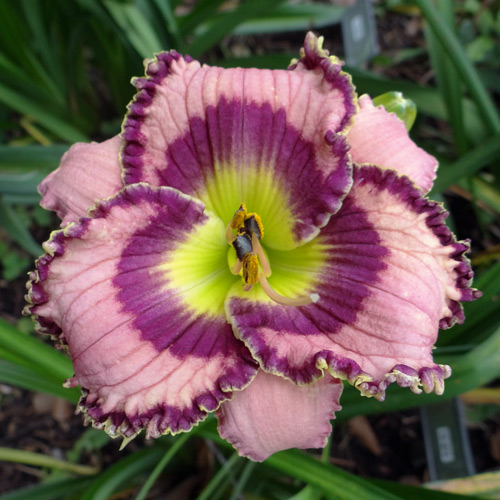
Seedling 14-034
 
Edwardian Charm Happy Halloween Happy Halloween
Today's seedling is 14-034. It resulted from the cross [Edwardian Charm x Happy Halloween]. Edwardian Charm has super branching and bud count and I'm hoping 14-034 will inherit that from it. On the surface it doesn't look like 14-034 inherited anything from Happy Halloween but it did. It inherited substance which was somewhat lacking with Edwardian Charm.
|
 August 5th, 2015 August 5th, 2015 |
** Notice to AOL users **
I'd like to apologize to any AOL users who may have emailed me but have not received a response. I always answer my emails but for some reason replies to AOL users don't always get through. There's one person witn an AOL account that I email on a regular basis and about half the time, the email bounces. The bounce messages I get back varies from 'AOL mail server does not want to talk with you right now' to 'the transmission was terminated abruptly' to 'the AOL server is busy, try sending again later'. I just wanted to let you know that I am trying to reply, but I'm just not getting through.
It was a sad day in the garden. Today is the FDWB day, a day that saddens me every year. FDWB stands for 'first day without bloom' and yes, there were NO blooms in the garden today. This doesn't mean there are no more blooms to open - just that there were no blooms to admire before heading out to my day job.
The opposite of FDWB is the more popular FBO day (first bloom open). Just about every daylily person observes that day but FDWB is pretty much ignored... probably because it's not a happy day.
So what's a person to do on such a sad occasion? Post a picture of course! (smile)
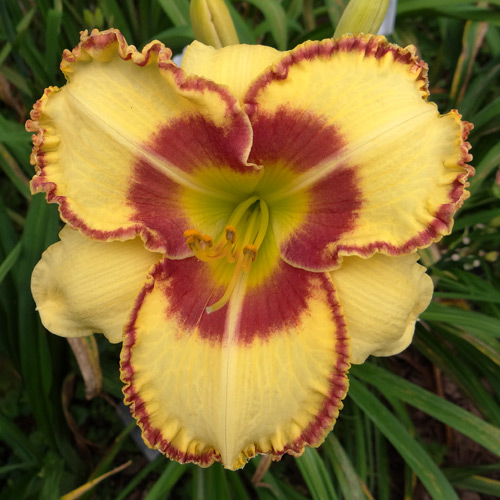
Seedling 15-015
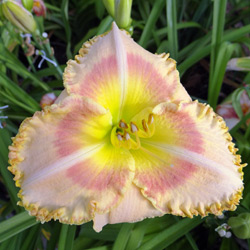 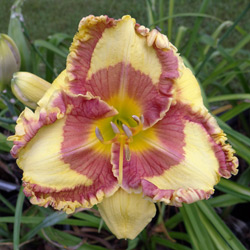
Sunshine Kisses Fashion Police Fashion Police
Today's picture is of seedling 15-015, new this year. It performed fairly well considering the overcrowded conditions of my seedling bed with 4-way branching and 20 buds. It should do better once it 'gets its own place' in the garden. It came from the cross [Sunshine Kisses x Fashion Police] also pictured.
|
 August 2nd, 2015 August 2nd, 2015 |
Today's seedling was one that first bloomed last year and almost didn't get selected for evaluation. Seedling 14-029 didn't command any attention when it bloomed. In fact, the bloom was small, fairly ordinary looking, and didn't open very well. The only thing it had going for it was a dark eye and matching edge. Having a spot available, I selected it as one of the last chosen.
The first scape this year wasn't much different than last year and I made a mental note that this would probably be one of those 'in and out the next year' seedlings destined for the compost heap. I don't know... perhaps it read my mind and the thought of being tossed on the compost heap scared it into action but the rebloom scape was much better. The bloom started opening symetrically and flat and even the color improved. The key improvement however was the bud count and branching. The first scape had about 10 buds on 2-way branching but the rebloom had 30+ buds on 4-way branching. To me, even a fairly average bloom can be a decent daylily if it has lots of branching and bud count. I'm looking forward to seeing what it does next year after getting fully established.
The parentage was [Goldenzelle x Bella Vita] pictured below.
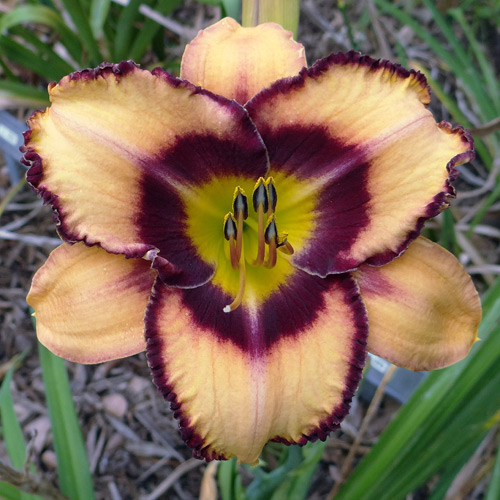
Seedling 14-029
 
Goldenzelle Bella Vita Bella Vita
|
 August 1st, 2015 August 1st, 2015 |
Today's seedling picture is 14-044. It came from the cross [CHRISTOPHER MOODY x sdlg 10-002] (both pictured below). It's too early to have a track record regarding performance but it did scape 3 times this year after being transplanted last fall.
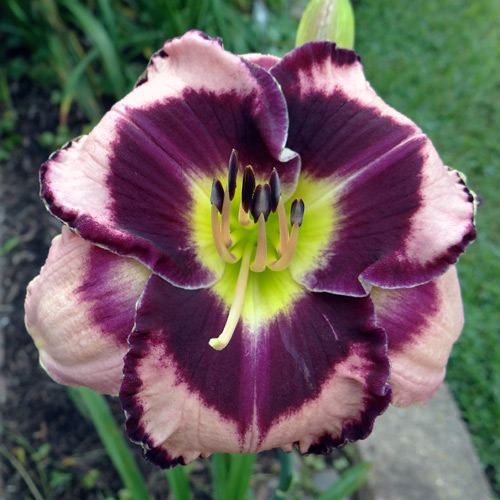
Seedling 14-044
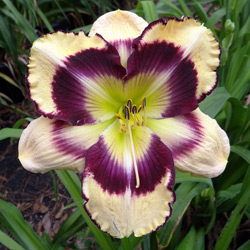 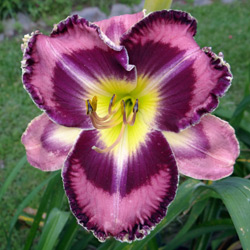
Christopher Moody Seedling 10-002 Seedling 10-002
|
 July 31st, 2015 July 31st, 2015 |
Both of the pictures below are seedling 14-039. The picture on the left was taken the morning of May 22nd. Daytime temperatures were in the low to mid 80's. The picture on the right was taken the morning of June 10th at which point the daytime temperatures were reaching into the low 90's. You can see the affect that the heat had on the color of the bloom making it quite a bit lighter.
This past week a third set of scapes finished blooming and the bloom color was a light cream color with only the slightest hint of lavender (sorry, no picture). The daytime temperatures have now reached into the upper 90's and hit 100 degrees 3 days in a row.
This is an example of what heat can do to the color of some daylilies. As the temperatures increase, the color gets lighter. This holds true especially for lavenders and pinks. The yellow edge color didn't seem to be affected by the heat however. It was pretty much the same color regardless of the temperatures. Even the light cream color this past week had the same yellow edge.
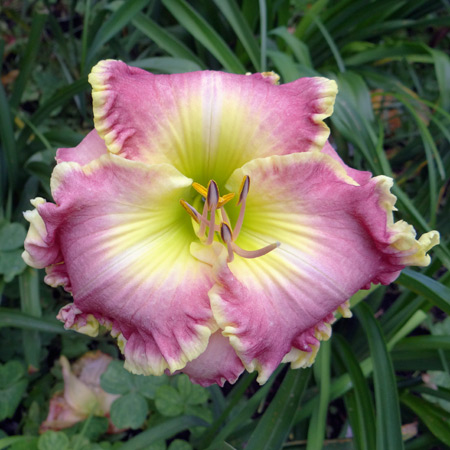 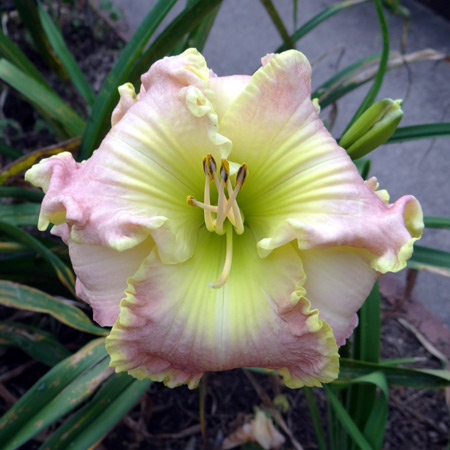
Seedling 14-039
I really like the big green throat on this seedling.
|
 July 26th, 2015 July 26th, 2015 |
Usually at this time of the year I am harvesting seeds for fall planting. This year however I did not make any new seeds. Hybridizing at the level I've been doing it all these years takes a great deal of time and pretty much keeps me tied to the house. I'll be retiring soon and want to be able to spend more time with my wife doing a little traveling and whatever else we decide sounds like fun.
I did transplant the seeds I planted last fall so I'll have one more good crop this coming spring. Who know... perhaps after my wife and I get the wanderlust out of our systems, I may start hybridizing again but it will surely be on a smaller scale.
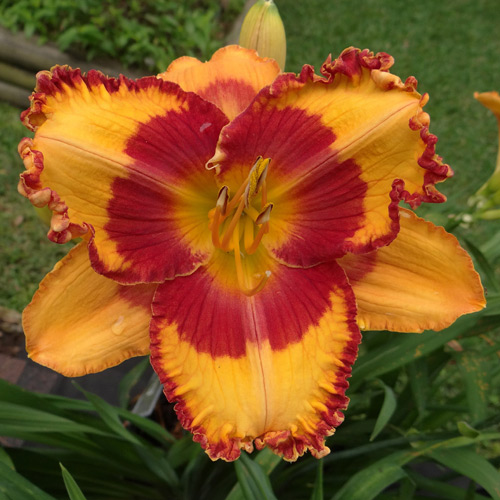
Seedling 13-069
Today's seedling is 13-069, a cross of ORANGE CITY x CARRIBBEAN MAGIC. I like its bright gold color and bold red eye and edge. It also has a somewhat distinctive petal shape with the petals often seeming to be a little squared off on the ends. Unfortunately, it doesn't open as well as I'd like early in the season although it gets better as the temperatures heat up.
|
 July 23rd, 2015 July 23rd, 2015 |
It wasn't that many weeks ago it seemed like it was raining almost every day. Now a summer heat wave has dried up the rain and I'm having to water on a regular basis.
I have occasionally seen something called 'summer dormancy' where a daylily will appear to go dormant for a short time before re-emerging. This year I am seeing quite a bit of it which is unusual. I always enjoy trying to figure out why things happen in the garden and as usual, I have a theory.
The wet spring caused most of my daylilies to rebloom more than usual including a very respectable number with 3 sets of scapes. Then just as the plants had pretty much finished blooming, the rain stopped abruptly and it got hot. It's been in the mid 90's for a few weeks now. My theory is that the plants had used up much of the resources stored in their roots blooming. They temporarily went dormant because then the roots couldn't keep up with the transpiration through the foliage.
While the plant appeared dormant, the roots were probably growing and replenishing their reserves. Most have begun sprouting new foliage even though the temperatures have been in the upper 90's for about a week now.
Is this actually the case? I don't know but I always enjoy trying to figure out why things are the way they are in the garden. It's part of the fun!
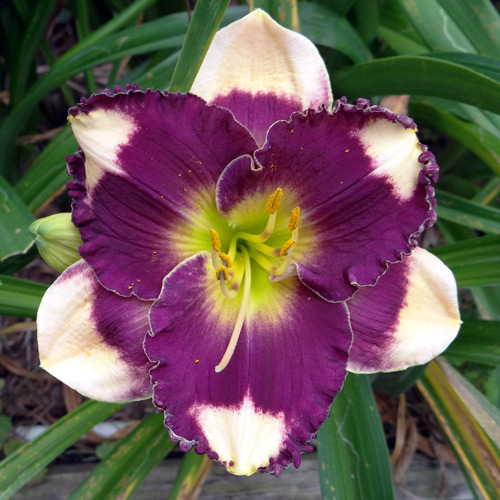
Seedling 15-050
Seedling 15-050 above is another new one from this year. While the bloom has to stretch to make 5", the dark purple contrasting with the creamy white makes it stand out from all the way across the yard.
|
 July 19th, 2015 July 19th, 2015 |
A couple of posts ago, I recommended joining a local daylily club. I also recommend joining the American Hemerocallis Society. While the local club gives the opportunity to meet and mingle with local daylily enthusiasts, the national club provides a wider exposure to the daylily community. Yes... us daylily 'nuts' think of ourselves as a community (smile).
I can remember back in the early 90's when some of our local club members who were not AHS members would ask "Why should I join AHS? What benefits are there to me?". For the most part, all we could say is you receive the AHS Journal quarterly and you can go to the national meeting. Today however, there are more benefits to joining AHS. Here is a partial list.
- A subscription to the Daylily Journal issued quarterly containing articles of interest to daylily enthusiasts written by knowledgeable daylily people. It is in full color with tons of daylily pictures.
- The ability to attend the AHS National Convention. During the convention there are bus tours to the best daylily gardens in the area.
- Automatic membership in your regional AHS organization. Here in Texas, this membership includes a regional newsletter issued 3 time a year with information aimed toward daylily growers in our region. This journal has lots of color too.
- Access to the AHS membership portal, an online community.
- Access to the AHS Email Robin, a group of members over 1200 strong that share ideas via an email mailing list. This is a great place to get your questions answered.
- Access to the AHS Media Library.
- And much, much more!
There is lots more information about the AHS available on their website.
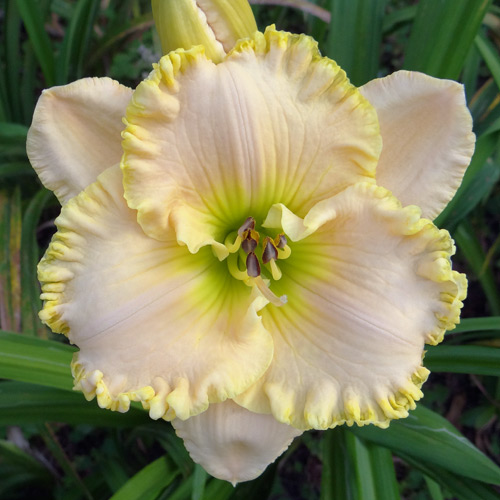
Seedling 15-037
Today's seedling is number 15-037, new this year. I have always liked cream colored daylilies even though most are not particularly unique. Perhaps it's because many of them have a near perfect form - round and flat with great symmetry. 15-037 is that with a ruffled yellow gold edge and a green throat.
|
 July 15th, 2015 July 15th, 2015 |
After I uploaded my post last night, I thought about how it might be interesting to see images of the parentage of seedling 14-084 back a couple of generations.
So here's the first cross.
 + +
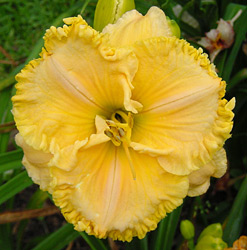 = =
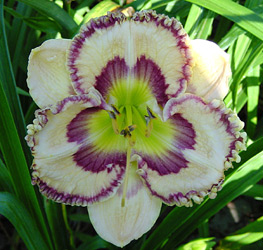
Hedwig's Eyes Spacecoast Gold Bonanza Spacecoast Gold Bonanza Seedling 07-003 Seedling 07-003
And here's the 2nd cross using the seedling from the first cross.
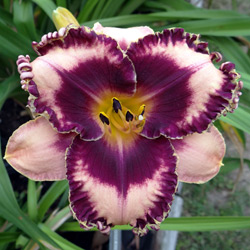 + +
 = =

Always Baroque Seedling 07-003 Seedling 07-003 Seedling 10-046 Seedling 10-046
And here's the 3rd cross using the seedling from the second cross.
 + +
 = =
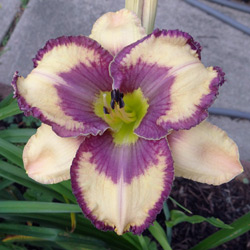
Shipwreck Cove Seedling 10-046 Seedling 10-046 Seedling 14-084 Seedling 14-084
This just goes to show the variety of results that can be realized when hybridizing with tetraploids... which is why I like hybridizing so much!
|
 July 14th, 2015 July 14th, 2015 |
I haven't posted for a while because I've been busy putting together my daylily club's yearbook. I had to learn new software (Microsoft Publisher) so it was slow going at first. But once I got the hang of it, the entire 24 page booklet came together quite well.
I have been a member of the Houston Hemerocallis Society since the 80's. I highly recommend joining a local daylily club both for the fellowship and the ability to exchange ideas with fellow dayily enthusiasts. In addition to getting together for meetings, we also have a Christmas party at a restaurant and this year we even took a bus trip to a daylily farm.
It's true that as a member of a club, you are asked to help out in some of the club's activities but working together with friends toward a common goal is rewarding. The goal of the Houston Hemerocallis Society is to 'spread the word about daylilies' (my words, but they echo the sentiment of the club).
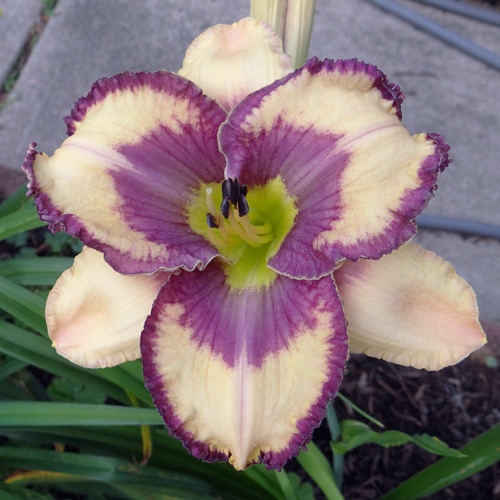
Seedling 14-084
This is seedling 14-084. It doesn't look much like either of its parents. The pod parent was Shipwreck Cove, an off white with a dark purple eye and edge. The pollen parent was a seedling that had a faded reddish purple eye and edge. I like the lavender purple eye with the applique throat. The applique throat came from one of the parents of the seedling (another seedling).
|
 July 5th, 2015 July 5th, 2015 |
I'm still seeing some bloom in the garden. In fact, because of all the rainfall this year there are probably more blooms than I usually have at this time. The majority of the blooms are less than spectacular but it's still nice to see some color in the garden.
There are lots of spent scapes everywhere. Some people like to remove the scapes as soon as the last bloom has finished so the garden will look well groomed. It does make for a nice tidy looking garden. However, I always leave the scapes in place until they dry up, turn brown, and can be removed easily with a little tug. While I have no scientific evidence to back me up, it's my belief that the nutrients left in the scapes after blooming will be drawn back into the plant as the scape dries.
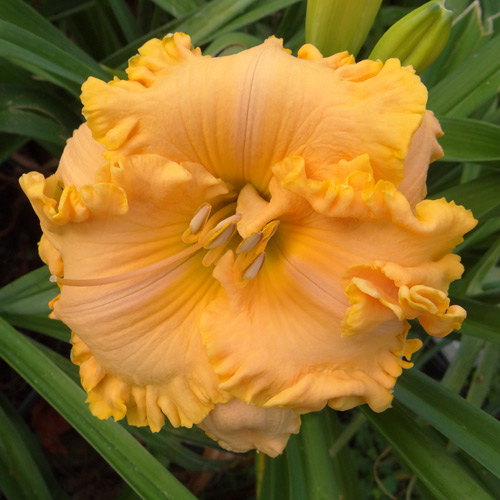
PATSY CLINE
Yesterday I had a couple of blooms of PATSY CLINE open on a rebloom scapes. The blooms looked almost as good as the first blooms back in mid May. It's quite rare for reblooms this late in the season to look as good as the first blooms of the season. PATSY CLINE took 'Best Extra Large Flower' in our club flower show this year.
|
 July 4th, 2015 July 4th, 2015 |
Happy 4th of July!
I've been too busy at work for the past week to wrap my mind around anything daylily. But being the 4th, I thought I'd reach back into the photo archives and find something to post with America in the name.
This daylily was hybridized by the late Dr. Bob Carr. I never had the pleasure to meet Bob personally, but I did have the opportunity to speak with him on the phone a couple of times. He was soft spoken and had a wonderful sense of humor. What was originally to have been a five minute call to check availability sometimes ended up lasting 30 minutes or more.
Bob was a member of the American Hemerocallis Society Email Robin. Every year when daylight savings time came around, Bob would post that the daylilies should really take off now because daylight savings made the sun come up an hour earlier. It always made me smile and even now, I often think about that post when daylight savings comes around.
Bob registered 135 cultivars of which I grew 11 over the years. This is one that always performed well in my garden.
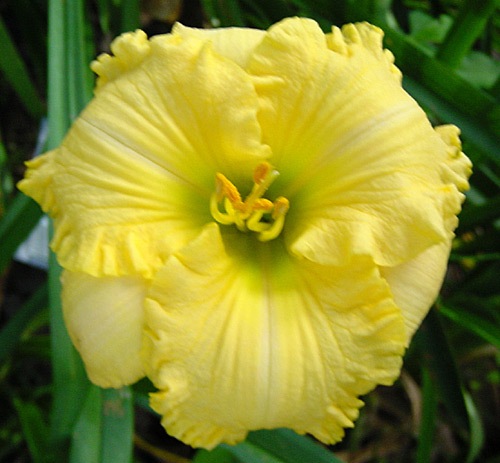
AMERICA'S MOST WANTED
|
Previous Posts
 Back to current posts
Back to current posts
|

 August 30th, 2015
August 30th, 2015 August 28th, 2015
August 28th, 2015 August 23rd, 2015
August 23rd, 2015 August 16th, 2015
August 16th, 2015 August 8th, 2015
August 8th, 2015 August 5th, 2015
August 5th, 2015 August 2nd, 2015
August 2nd, 2015 August 1st, 2015
August 1st, 2015 July 31st, 2015
July 31st, 2015 July 26th, 2015
July 26th, 2015 July 23rd, 2015
July 23rd, 2015 July 19th, 2015
July 19th, 2015 July 15th, 2015
July 15th, 2015 July 14th, 2015
July 14th, 2015 July 5th, 2015
July 5th, 2015 July 4th, 2015
July 4th, 2015 Back to current posts
Back to current posts






















 +
+
 =
=

 +
+

 +
+



